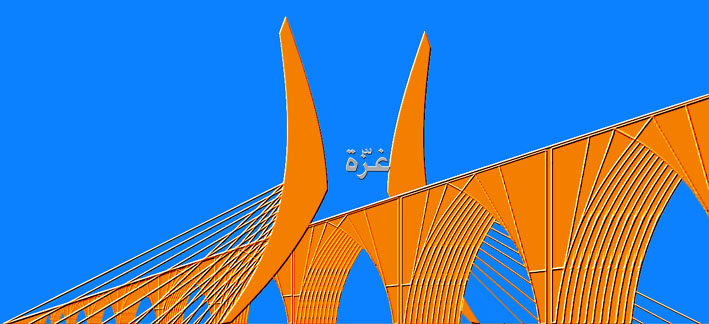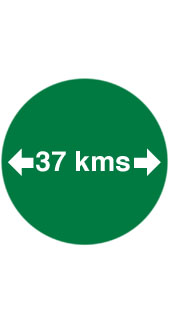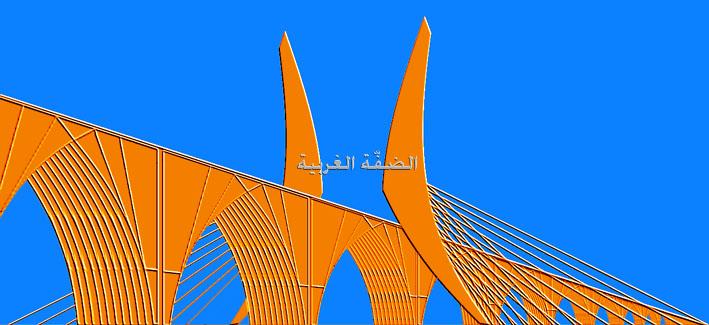|
“A
Bridge Linking the Gaza Strip to the West Bank?” by Alisa Klein
Overview:
7 October 1999
Israel
is about to open a “safe” passage between Gaza and Tarqumiyah,
one of two safe passages originally stipulated in the Oslo agreements.
In fact, since Israel reserves the right to determine who may
use this passage and to detain its users at will, to describe
it as a “safe” passage is misleading. Akiva Eldor, journalist
for the Israeli daily Ha’aretz, has asserted that this new safe
passage, “[f]rom [Israeli Prime Minister] Ehud Barak’s perspective
… is merely a temporary interim arrangement” (6 October 1999).
Campaigning
on the slogan, “They [the Palestinians] are there, we [the Israelis]
are here,” Barak has made physical separation of the two populations
a central goal of his government. He confirmed this goal in an
interview, published on 18 June 1999 by Ha’aretz, while he was
ensconced in negotiations to form a coalition government. In the
interview, conducted by correspondent Hannah Kim, Barak discussed
publicly, for the first time, his intention to build a highway
on pillars or, as he called it, a “bridge” designed to link the
Gaza Strip with the West Bank and further separate the Palestinians
from the Israelis.
Regarding
the bridge, he said: “Certainly there will be one. Seven years
ago, on the day the [Declaration of Principles, known as the]
Oslo Accords were signed, I told [then-Israeli Prime Minister]
Yitzhak [Rabin]: Tomorrow, at this moment of grace, with the whole
world ready to pitch in, you have to build a bridge on pillars
from Beit Hanoun to Dura [Beit Hanoun is on the edge of the Gaza
Strip, and Dura, near Hebron, lies along a straight line from
it]. A
bridge like that, which is effectively a highway of 47 kilometers,
will cost perhaps $200 million, and we have to start building
now. I told him there would be no end to the security problems
and to the negotiations with [the Palestinians], so it is imperative
to do two things right away: build a Jericho by-pass road and
plan the bridge-highway.
I
told Yitzhak that I had seen a bridge-highway like that in Miami,
ten kilometers long. The Kafr Kassem interchange also has 700
meters of a similar bridge-highway. A kind of highway on pillars
for 47 kilometers, with four lanes, a railway line, a water pipe,
a communications cable—that’s about what is needed. It’s a relatively
simple thing. Rabin didn’t do it because he was preoccupied with
hundreds of other matters in the negotiations.” Barak continued:
“ … there is no more to be said, it will happen, it’s not pie
in the sky, these are necessities of life. Will I do it? For sure.
You can’t make people [the Palestinians] disappear just by saying
so.” (Emphasis added.)
The
Search for Information: Despite Barak’s insistence that the bridge
is practically a “done deal,” information regarding his proposal
was not to be had from 11 Israeli government offices contacted
in July, including the Office of the Prime Minister and the Transportation
Ministry. Aviatar Manor, Director of the Office of the Deputy
in charge of the Middle East Peace Department of the Foreign Office
said, “I read [about the bridge] in the papers just like you.
There is no governmental program like this. Perhaps Barak threw
it out as just one of many possible ideas.”
Mark
Sofer, of the Foreign Ministry’s Finance Department, remembered
that, about five years ago, he had seen models by a Swiss company
of a highway bridge linking Gaza and the West Bank. Sofer claims
that the option was not pursued because the bridge was deemed
“not feasible because of the cost, because of the land that would
need to be made available … and because, from an engineering point
of view, [it] would be too difficult to carry out.” Nachum Gabai,
the Ministry of Transport’s officer in charge of transportation
in “Yehudah and Shomron” (Hebrew for “Judea and Samaria,” Israel’s
term for the West Bank and Gaza) said the bridge had been a “generalized
idea, but [that it] was never brought to any practical level.”
Dr.
Ron Pundak, who was involved in negotiating the Declaration of
Principles in 1993 and now serves as a director of the private
Economic Cooperation Foundation, was also unable to produce additional
information about Barak’s plans. He did confirm, however, that
the idea of a “highway on stilts” was first “bandied about” in
1992 or 1993, when individuals involved in the work connected
with Oslo were looking for an idea for passage between the Palestinian
territories. The Israeli government, he said, “wanted a route
that could be under Palestinian control without Israeli interference
or ability by the Israelis to limit Palestinian passage or traffic.”
The Palestinian Response: Four days after the Barak interview,
on 22 June 1999, the Ramallah-based newspaper, al-Ayyam, published
an article analyzing Barak’s proposal for a bridge between Gaza
and the West Bank. Relying heavily on material produced by the
Palestinian Economic Council for Development and Reconstruction
(PECDAR), which implements infrastructure projects in the Palestinian
territories, the article made clear the folly of such a proposal.
Foremost
among the reasons PECDAR supplied regarding the unfeasibility
of the proposed bridge was its cost. Compared with Barak’s estimated
cost of an approximate $200 million, PECDAR claimed the proposed
bridge would cost around $10 billion. PECDAR Director-General,
Mohammed Shtayyeh, told al-Ayyam that the bridge was technologically
possible but financially infeasible. According to Shtayyeh, to
date, donor countries have disbursed only about $2.4 billion out
of $3.8 billion pledged to the Palestinians over the last five
years, making it unlikely that international donor countries will
provide the funding the project would require. Furthermore, donor
countries have pledged only three billion dollars for the next
five years. Slated for a wide range of projects, these funds do
not even come close to PECDAR’s estimated $10 billion cost of
the bridge.
Shtayyeh
also pointed out that the bridge would take somewhere between
two and six years to construct and suffers from another important
drawback. Since the bridge is meant to link the southern region
of the West Bank with the Gaza Strip, it is not beneficial to
Palestinians wishing to travel within the West Bank. Travelers
moving from south to north have only one option—the Wadi an-Nar
road, a notoriously slow and dangerous roadway. As such, the bridge
falls short of the two safe passages between Gaza and the West
Bank mandated by the Oslo Accords. The first, soon to be opened,
links Gaza with Tarqumiyah, while the other is to connect Gaza
with a checkpoint close to Mevo Horon near Ramallah.
Political
Implications: Asked in the Ha’aretz interview whether the bridge
would bolster the establishment of a Palestinian state, Barak
indicated that, “[former Israeli Defense Minister] Arik [Ariel]
Sharon said already a year ago that a Palestinian state exists,
[former Israeli Defense Minister] Moshe Arens said the same thing
a month ago. I don’t say it because I am not a commentator. We
will conduct negotiations with them … [The bridge] is the simple
part of the issue. The difficult part is a few subjects that will
come up at the end.” While it is unlikely that the bridge will
be built, despite Barak’s protestation that “it will happen,”
what is more important is how Barak ultimately will deal, in actuality,
with questions of Palestinian land contiguity and freedom of movement.
Meanwhile, the proposed bridge will endure as a symbol of Barak’s
intention to physically separate Palestinians from Israelis to
the fullest possible extent.
Alisa
Klein is editor of The Other Front, a weekly internet analysis
of Israeli politics and society published by the Alternative Information
Center in Jerusalem (see www.aic.netgate.net). The above text
may be used without permission but with proper attribution to
the author and to Palestine Center. This brief does not necessarily
reflect the views of the Palestine Center or The Jerusalem Fund.
This information first appeared in Information Brief No. 9, 7
October 1999.
.
|




 .
.